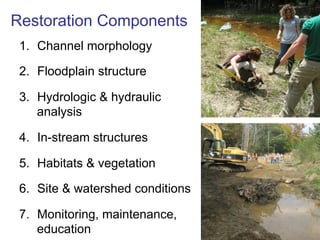This document discusses stream restoration and healthy stream ecosystems. It notes that streams should have a stable bed and banks, allow sediment transport, and have diverse habitat and flows. Unhealthy streams may be straightened and lack buffers. Restoration aims to improve habitat, hydrology, and resilience. Successful projects meet ecological standards and assessment, and have measurable improvements. Design approaches include threshold channels or alluvial channels based on reference reaches, equations, or models to set dimensions, pattern, and profile.
























































